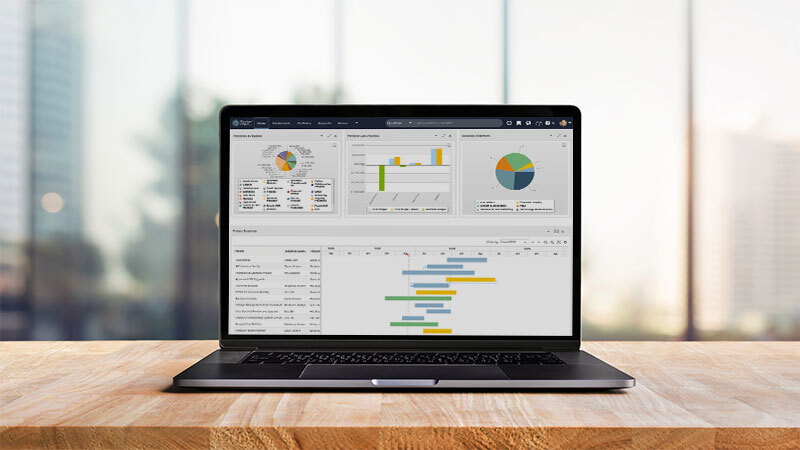
Does your PMO generate portfolio dashboards for stakeholders and executives? If so, do those portfolio dashboards offer the right insights and data to help inform and empower your business leaders to make quick decisions? Does it help your PMO be seen as a value driver?
In a 2019 Deloitte survey of 1,000 U.S. executives, 67% revealed they are not comfortable accessing or using data from their tools and resources. Even among those who consider their organizations strongly “data-driven,” 37% still expressed insecurity.
The Savvy PMO recognizes this and makes access to highly visual, useful data an imperative by providing comprehensive portfolio dashboards. This is especially crucial today as organizations are making rapid changes in strategies, priorities, and budgets. They must understand the short- and long-term impacts.
In Part 1 of this blog series, we covered the first three of the six visibility areas PMOs should develop on their way to becoming a more strategic advisor to the business:
- Project Status and Health: Keep projects on track
- Planned vs. Actuals: View performance against plan
- Intake and Demand: Choose the right work to pursue
The Savvy PMO builds upon project-level reports to create progressively more sophisticated, portfolio dashboards. The final three areas focus on creating high-quality, timely reports and visualizations that stakeholders can easily use to make good decisions and ensure that portfolios are delivering on strategy:
- Portfolio-Level Visibility
- Executive-Level Visibility
- Real-time Analysis
For each area of visibility, the Savvy PMO should determine the audience, purpose, outcomes, and benefits. Starting with portfolio visibility, here are the remaining visibility areas:
4. Portfolio Visibility: Driving Alignment and Value
High-level visibility into the state of the portfolio enables executives and portfolio managers to plan and execute the highest-value initiatives in context, balancing across financial and resource constraints. They can keep an eye on progress and make course corrections as needed. Here are three types of information to include on portfolio dashboards:
- Strategic Alignment: Provide insights into how the portfolio is meeting strategic goals. Include all approved project investments that align to these objectives. With this information, the program or portfolio manager can verify that all work is connected to the strategic plan.
- Financials: Create comprehensive views into budgets, actuals, and forecasts. Highlight how costs break down by portfolio project, capitalized versus non-capitalized expenses, innovation, compliance, “keep the lights on” activities, and more. Depict financial KPIs for stakeholders to understand trends, make improvements, and optimize capital spend over shifts, delays, or new opportunities.
- Health and Project Summary: Supply visualizations into the portfolio’s high-level status and performance. This shows at a glance if projects are on time and on budget. Graphical reports can highlight project health metrics such as schedule, cost, and resources.
5. Executive-Level Visibility
The Savvy PMO knows that business leaders need customized, easy-to-understand reports and portfolio dashboards that provide the right information for their needs. In addition to the ones recommended in areas 1-4, consider new ones for executives by reflecting on what they continually ask about the portfolio, such as:
- Are we working on the right projects to support our business goals and objectives?
- Do we have enough people with the right skills available to complete the work?
- Are we within budget and getting the expected return on investment?
- Do we have the right mix of projects and products to meet our strategic initiatives?
Help answer these types of questions by adding the following drillable data to portfolio dashboards:
Work Intake: Show the volume of demand coming into the executive’s organization and where it is in the overall governance process.
Resource Capacity Versus Demand: Based on current demand, depict whether or not the organization can take on new work and if so, when. This helps executives understand why certain projects cannot be staffed and make decisions such as hiring more people or increasing capacity by deprioritizing other projects.
Top Projects Health: Provide focused views into how the business leader’s top projects are performing. Red status indicators alert leaders to problems or risks. They should have the ability to drill down further into a project to see open issues, percent complete, schedule, costs, and more.
Work Type by Budget: Render if and how the work is balanced across growth initiatives versus run-the-business activities, for example. Clear insights will confirm that the organization is investing in the right areas of work or that changes are in order.
Portfolio Hierarchy: Tailor portfolio dashboards to each executive’s functional area, such as the CTO, CFO, or CMO. Include the associated projects with all relevant details.
6. Visibility and Real-Time Analysis: A Game Changer
Of course, executives rarely work in a vacuum, especially with initiatives becoming increasingly complex and cross-functional. Savvy PMOs integrate real-time information from across the organization into their centralized PPM tool. With this data and analytics, they can help stakeholders visualize and analyze trends and interdependencies across the business.
To facilitate the best business decisions, drive insights beyond status such as:
Impact Analysis: Display dependencies between portfolios, projects, people, and assets. Real-time views into the status of resources and activities should be tied to strategic objectives. As priorities and budgets change and resources shift, portfolio and resource managers as well as executives and finance can see the domino effects.
KPI Trend Analysis: Capture weekly and monthly snapshots of vital portfolio and project metrics. Perform trend analyses to ensure everything is on track and take corrective measures if not.
What-If Scenario Planning: Provide interactive visualizations to model the impact of changes (such as unplanned work), compare trade-offs between proposed decisions, and see the reallocation of resources and funding over different timelines. Forward-looking data facilitates resource planning and optimization, with views by portfolio, project, role, or individual that can be toggled to find the right mix.
Predictive Portfolio Analysis (PPA) and Optimization: Automatically build the highest value project portfolio based on any resource and budget constraints and compare portfolio scenarios. This saves time from having to manually analyze the data (and thus giving time back to be better utilized on other tasks and activities). When resource requirements or budgets change, managers can easily re-plan the portfolio.
The right data and analytics help Savvy PMOs, and their business colleagues, ensure that the organization is delivering on strategy. Real-time data sources and feedback loops are critical for this, ideally fed into a PPM tool that provides a single source of truth for everyone. Highly illustrative, customized reports, analytics, portfolio dashboards, and KPIs give stakeholders the information they need, in ways that are the most comprehensible and valuable to them.
As a good steward and purveyor of information, the Savvy PMO can facilitate and make effective decisions for the business. They can offer informed recommendations supported by facts and evidence, raising the PMO’s profile with executives and other leaders in the process. As a result, the organization can more effectively achieve strategic objectives, mitigate risk, and capitalize on new opportunities.
For more details on all six areas, download the Savvy PMOs Guide to Visibility and Reporting eBook. Also check out the other eBooks in the Savvy PMO series:



![Planview Recognized as a Leader in 2018 Gartner Magic Quadrant for Project Portfolio Management [Infographic]](https://blog.planview.com/wp-content/uploads/2018/06/Gartner-MQ.gif)


